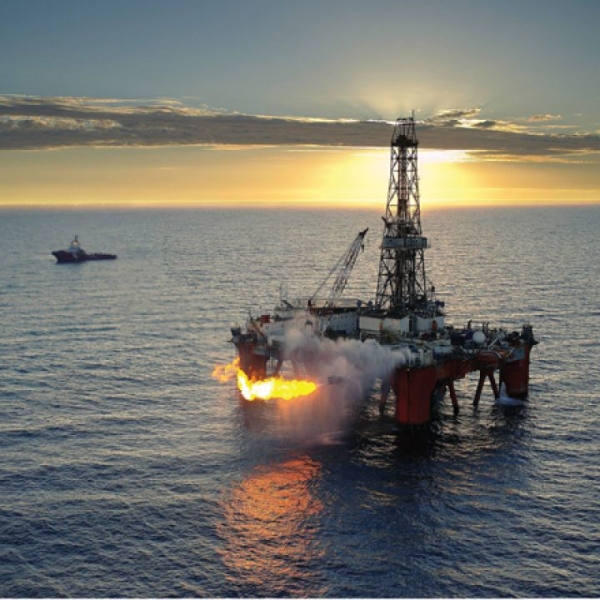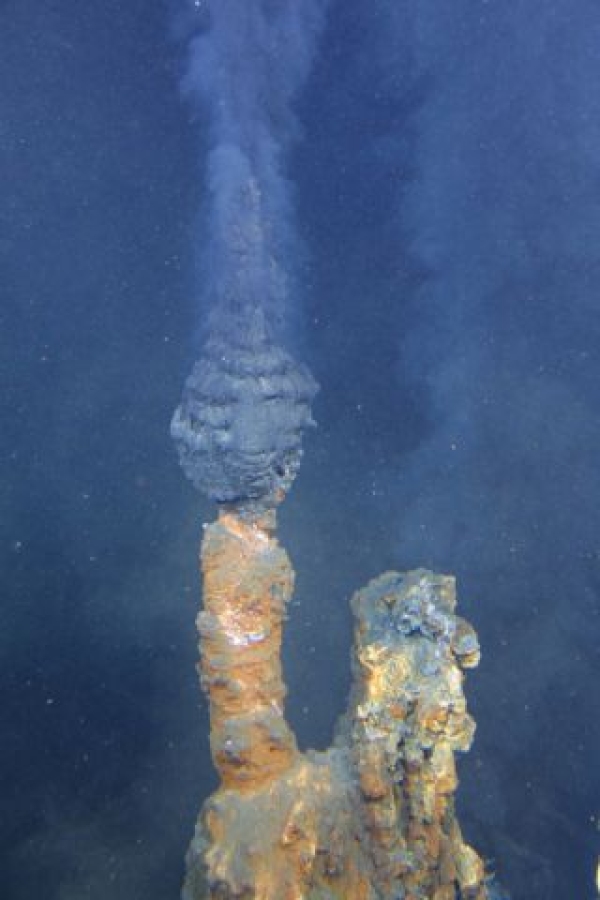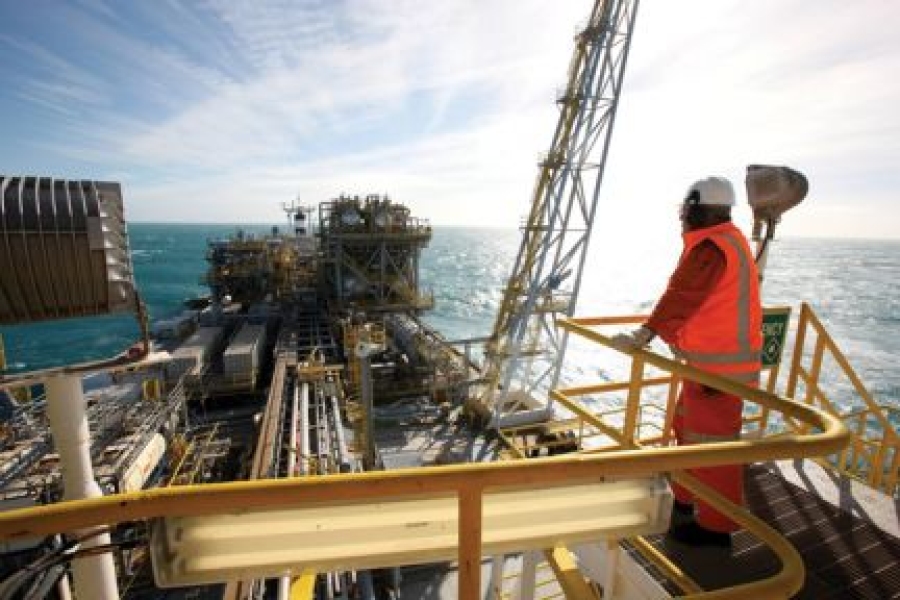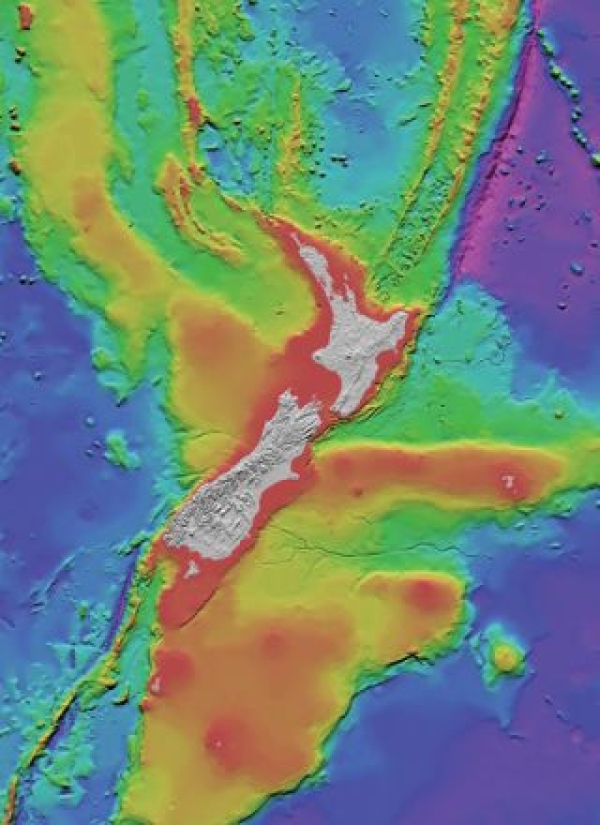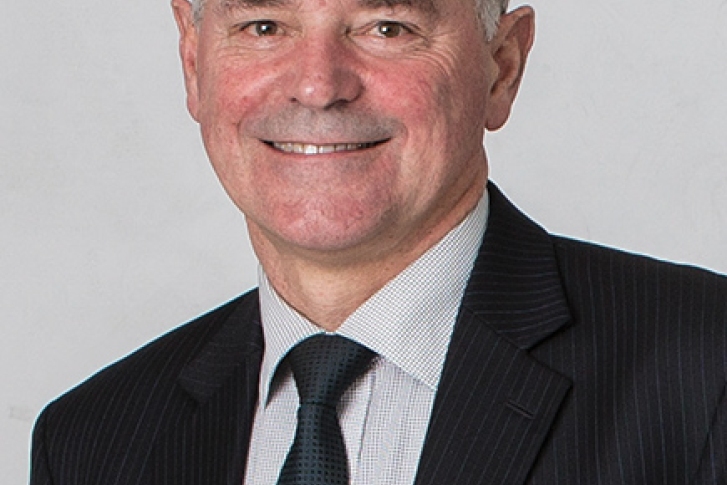New Zealand’s ocean estate spans over five million square kilometres. Research and exploration suggests that the vast seabed holds mineral resources worth many trillions of dollars. But is extraction realistic? How can the impacts be managed? And why is there an urgent need to revisit New Zealand’s oceans' policy?
Jim Robinson talks to the specialists, and asks: what’s the role of science in delivering the answers?
Almost 20 million barrels of oil and over 140 billion cubic feet of gas were piped from New Zealand fields in the 2009 calendar year. Some came from onshore Taranaki – but most came from the seabed. If estimates released in 2010 by the Ministry of Economic Development prove correct, in another 20 years annual earnings from New Zealand’s offshore hydrocarbons could be tens of billions of dollars.
But while oil is the seabed mineral resource most Kiwis would think of first, the potential goes far further. Nothing else is into production yet, but across New Zealand’s 12 nautical miles of territorial waters and 200 nautical miles of Exclusive Economic Zone (EEZ), there are substantial proven mineral reserves: notably phosphates, massive sulphide deposits, and ironsands.
While these are early days in ascertaining the precise scope of reserves, and the technical and economic viability for extraction, the potential value is immense. Numerous New Zealand and international companies and ventures are spending hundreds of millions of dollars a year on prospecting and exploration.
Yet, here’s the sting. Just as nobody knows the full extent of reserves, nobody knows the full extent of the environmental risks of extraction, let alone how to mitigate those risks. There’s some knowledge about deepwater species and ecosystems, potential impacts, and steps to recovery, but the understanding is far from comprehensive. What is certain is that deepwater environments themselves have immense value, supporting sustainable fisheries and perhaps carbon sequestering, as well as holding their own intrinsic worth.
“Given the value of the mineral resources and how many companies are now interested, it’s time to ask some serious questions about how to manage them,” argues Dr Alison MacDiarmid, NIWA Principal Scientist, Marine Ecology. “We need to balance mineral extraction with the other benefits of the marine environments. Some degree of exploitation of the resources is probably fine. But what degree? What is the balance?”
And to even begin answering that question, we first need to know what’s down there.
Phosphate on the Chatham Rise
Thanks to government-led exploration, sampling, and research from the 1950s to 1980s, it’s well known that the crest of the Chatham Rise holds major phosphate deposits. Phosphorite nodules sit in sandy silt in the top 70 centimetres of seabed, at sea depths around 400 metres. When crushed, they produce a proven slow-release fertiliser. Estimated reserves exceed 100 million tonnes, enough to meet New Zealand’s current phosphate requirements for decades.
Even so, there has never been commercial production from the Chatham Rise. In large part that’s because of the 1980s discovery of huge phosphate reserves, largely in Morocco. But in recent years, rock phosphate from Morocco has soared to US$500 a tonne, rekindling interest in the Chatham Rise reserves.
A joint venture between Widespread Energy and Widespread Portfolios of New Zealand currently holds a prospecting licence for a 4500 square-kilometre block, about 250 kilometres west of the Chatham Islands. For their feasibility studies, Widespread has accessed historic seabed samples, data, and research held by NIWA. NIWA has also undertaken oceanography and analysis of seabed communities.
The studies indicate commercial extraction is realistic. Widespread is currently raising capital to progress appraisal and could be ready to place a mining application in about two years’ time. As well as dredging companies, Widespread is liaising with the Department of Conservation, Ministry for the Environment, Ministry of Fisheries, and others.
“All the stakeholders will need to hold hands," says Chris Castle, Managing Director of Widespread Energy. “It’s imperative we work in harmony with the environment as much as we can. It’s not just lip service.”
Mr Castle notes that the total area of extraction sites will be just 300 square kilometres. The nature of the reserves means sites will be small and scattered. He also raises “a few big pluses” from production: savings to the New Zealand fertiliser sector would be an estimated $75 million a year, with assured continuity of supply and cost. And tapping supplies closer to home would slash fuel use and carbon emissions from transport.
Widespread’s prospecting licence requires that all activities comply with the International Marine Minerals Society’s ‘Code for Environmental Management of Marine Mining’. As a publicly listed venture, Widespread must also comply with stock exchange reporting codes.
Massive sulphide deposits on the Kermadec Ridge
The Kermadec Islands sit along the undersea Kermadec Ridge, around 1000 kilometres northeast of New Zealand at the boundary of the Pacific and Indo-Australian Plates. The islands are volcanic peaks. Other volcanoes, some the size of Mount Ruapehu, form underwater seamounts. The seamounts have pockets of thermal activity, where superheated fluids spurt through thermal chimneys. When the fluids hit the water, at up to 400 degrees, they harden into seafloor massive sulphide deposits (MSDs). These are typically about 20 metres thick and contain copper, lead, and zinc, as well as some silver and gold.
A black smoker at Brothers Seamount on the Kermedec Ridge, emitting a hydrothermal plume of mineral-rich fluid. (JAMSTEC/GNS Science/NIWA)
Since being discovered by GNS Science and NIWA researchers in the 1990s, the MSDs have attracted considerable commercial and scientific attention. Australian company Nautilus has applied for exploration licences. Neptune Resources, also Australian, has held licences, though these have largely been given up or revoked by the government agency Crown Minerals.
Should things proceed, most of the technology required for extraction already exists in the oil industry. Roving seafloor machinery would cut and vacuum up the sulphide. Slurry would be piped to the surface, where excess water would be removed and piped back to the seafloor, with solid material barged to land for processing.
First, however, there are serious questions to be answered. Are the deposits large enough and the minerals high enough grade to be economically viable? Above all, can the environmental issues be justified and managed?
“We’re looking at a one thousand-kilometre region with very complex topography,” explains Dr Malcolm Clark, NIWA Principal Scientist, Deepwater Fisheries. The thermal chimneys, called ‘black smokers’ or ‘white smokers’ depending on their chemical composition and temperature, spew hydrogen sulphide – fatal to most forms of life.
The unique creatures found around thermal chimneys are sensitive to disturbance, says NIWA's Dr Malcolm Clark. "So it's really hard to balance conservation versus exploitation." (IPY-CAML)
A whole group of organisms and animals, described as chemosynthetic, have evolved to live in the toxic environment. Instead of using the sun’s energy, these marine organisms rely on the chemical energy of the earth. They include tubeworms, stalked barnacles, crabs, starfish, huge mussels, and eel-like fish.
“Many chemosynthetic communities are extremely localised, according to the chemical conditions, temperatures, and currents. They are sensitive to even small-scale disturbance, so it is really hard to balance conservation versus exploitation,” Dr Clark cautions.
With any potential extraction still years away, there could be helpful lessons to learn from Papua New Guinea. Off the east coast, in the Bismarck Sea, there are large banks and seamounts with chemosynthetic communities and MSDs. Environmental assessments have been completed and mining of the deposits could begin as soon as 2012.
Ironsands off the Taranaki coast
For decades, iron-rich mineral sand has been extracted from ancient dunes at Taharoa and Waikato North Head. The ironsand is used for domestic and international steel manufacture and is worth almost $30 million a year.
Ironsand stretches along a 450-kilometre sweep between Whanganui and Kaipara Harbour. The titanomagnetite, magnetite, and ilmenite (iron and titanium oxide) minerals are eroded from the volcanic rocks of Taranaki.
Offshore Taranaki deposits have been known since the 1960s and could yield over 500 million tonnes of ore. Until recently, there was no impetus to define the reserves, but in 2008 global ore prices soared after the Chinese – the world’s major producers of steel – began stockpiling reserves.
“That sparked off the interest here. In the last two years, we’ve been approached by four or five mining companies wanting to know the knowledge base, distribution, and size of reserves,” says NIWA geologist Dr Alan Orpin. Several prospecting licences have been issued by Crown Minerals, with more pending. The companies are driving their own research programmes, gathering remote data by aerial magnetics and strategic seabed sampling.
NIWA has analysed historic ironsand samples for two multinational companies, one of which has an exploratory drilling campaign underway. An aside here: while much research is high tech, the veracity of geological interpretation still depends on basic observation. To validate the concentration of iron ore in a sample, geologists use a magnet on the end of a pencil.
As yet, offshore reserves are still “poorly defined,” Dr Orpin says. “There are some sedimentary bodies that are very rich in ironsands. But, to be economic, it’s all about volume. The scale of extraction we are talking about is vast.” NIWA scientists are working with mining companies to establish potential impacts.
A coastal environment is inherently more mobile than, for example, that of the deepwater Chatham Rise. Sands shift with currents, tidal flows, and storms, so species and ecosystems are naturally geared to recover from change. Nonetheless, the impacts the seabed and the organisms living there are a major concern.
Dr Orpin emphasises that NIWA’s role is to deliver answers that allow the best decisions to be made. “Our goal is to provide very sound, objective information. Big decisions will have to be made on the basis of acceptable risk. Both sides of the argument need to be played out.”
Offshore ironsand reserves fall within the 12 nautical mile limit, so any development and production will fall under the jurisdiction of the Resource Management Act 1991 (RMA), regional councils, and iwi.
Coastal sand extraction and the RMA Coastal resources aren’t the prime focus of this article, but it’s worth touching on coastal sands, used for building, construction, and beach nourishment projects like Wellington’s Oriental Bay.
With little suitable river sand, the Auckland region sees the most coastal extraction: over 350,000 cubic metres is taken each year from east coast beaches and the entrance to Kaipara Harbour. This contributes over half of the city’s concrete sand requirements.
Quality sand sits at depths of five to 15 metres, where the wave action has scoured away ‘the fines’ and the texture is even, explains Dr Terry Hume, NIWA’s Principal Scientist, Coastal Geomorphology. He observes that it’s extremely difficult to forecast the precise effects of extraction, because effects are blurred by natural ‘sand swapping’ between the beach and shallow nearshore, due to tides, currents, and waves. There’s no doubt, however, that removing sand from too close to shore can cause serious beach erosion.
Like ironsand, coastal sand extraction is covered by the RMA. Operators need to gain a coastal permit from their local council, with any appeals considered by the Environment Court. Dr Hume is involved in presenting assessment reports to hearings. He believes that in the main, the RMA works well: “It’s a pretty consultative and robust process.”
The way coastal sand extraction is managed is perhaps a precedent for activities further offshore. There’s clear legislation, there’s a commitment to ongoing scientific investigations and monitoring, and there’s a public voice. These factors all contribute to making sound decisions on resource allocation and use.
Zealandia’s petroleum potential
In the last financial year, petroleum was again New Zealand’s number three export earner. All current oil and gas production is around – and mostly offshore of – Taranaki. Since 2006, four new offshore gas and oil fields have come on-stream: Pohukura, Tui, Maari, and Kupe. Maari is New Zealand’s largest, reaching 40 000 barrels a day by mid 2009. Shell Todd Oil Services has been extending the life of the Maui field, producing since 1979, by drilling from two platforms.
Over the last decade, much has been learned about potential. Because it was once a large continent, now commonly called Zealandia, New Zealand’s surrounding undersea geography shows evidence of ancient river deltas – prime estate for hydrocarbons. To support exploration, the government continues to invest in seismic data acquisition.
Austrian energy company OMV holds a prospecting licence for the Great South Basin. In September 2010, OMV revealed that seismic mapping had identified potential hydrocarbonbearing structures in the basin. Other potential fields include offshore Canterbury. Nothing is definite, but a reasonable estimate of New Zealand’s recoverable petroleum reserves could be in the realm of ten to twenty billion barrels.
GNS Science is a key player in supporting the sector. NIWA’s participation is currently smaller, focusing upstream (such as researching fault geometry and sediment architecture) and downstream (such as environmental baseline studies, potential impacts, and location of rigs and pipelines).
Methane gas hydrates and future possibility
Only recently have gas hydrates been recognised as a potential energy source. “Gas hydrates are a bit of a holy grail at the moment,” enthuses Dr Geoffroy Lamarche, NIWA Principal Scientist, Ocean Geology. They’re an ice-like form of water, with methane gas molecules caught in the ice crystal, and they could become a key source of energy.
In depths beyond 600 metres, gas hydrates are trapped deep within the sediment. They form a plug layer above porous sediment containing free gas, usually methane.
“Gas hydrate research has undergone a fascinating paradigm shift in the past few years,” explains Dr Ingo Pecher, GNS Senior Research Scientist (Geophysics). “As an ice-like solid, it was always thought to be difficult to produce gas hydrate. However, in 2008, production tests of gas hydrates were completed successfully in the Canadian Arctic, using standard production technology. Suddenly, this somewhat esoteric research field has become very applied. It is conceivable that we will see commercial production of gas from hydrates within a decade.
“New Zealand has a promising gas hydrate province east of the North Island [the Hikurangi Margin],” says Dr Pecher. “With production tests planned offshore of Japan in a similar geologic setting in 2012 and 2014, our gas hydrates resource may be closer to being producible than we had hoped only a couple of years ago.
“If production becomes commercially viable, gas hydrates have the potential to become New Zealand's main source of natural gas for several decades,” he says. However, there are hurdles to overcome. Dr Lamarche explains the gas is trapped at such pressure that when released at the surface it expands 160 times: “It’s a massive technological problem and a hazard.”
GNS, NIWA, and the universities of Otago and Auckland have begun a government-funded project for the Hikurangi Margin. For GNS the main focus will be to quantify the concentration of gas hydrates and the quality of the reservoirs. NIWA will provide detailed information on the stratigraphic and geological architecture of the reservoirs and surroundings, and establish an ecological and biological baseline of potential exploration sites. A PhD student at the University of Otago will study potential reservoirs on the southern Hikurangi Margin, while initial production modelling will be performed at the University of Auckland.
“These studies will be critical for management and environmental protection of the sites,” says Dr Lamarche. Current funding is for two years but the aim is to assess optimal sites by 2015, when the industry will step in. Test drilling is scheduled by 2018.
The argument for adaptive management
“There will always be an impact from mining,” states Dr Alison MacDiarmid. Being dredged or sucked up to the surface then piped down again, with all the associated changes in pressure, light, and temperature, means few species or organisms will survive. “So the big questions are: how big an area is envisaged? And how fast can it recover?” “For deepwater, we don’t yet know the answers. For shallower waters, we know more about natural processes of change, so we can ascertain more of the effects of change due to mining. But deeper than 50 metres, natural disturbance is rarer. It’s much harder to build a picture.”
“Recovery time is a huge unknown. Every month we still are finding new deepwater species. We don’t know anything about their lifestyle, so we can’t say how long they will take to recover.” On land, mining is followed by restoration, but nothing is known about restoring a deepwater environment. This is why adaptive management is so crucial, she says. Essentially, adaptive management is about informed trial and error: learning as you go. There’s emphasis on monitoring and measurement, learning what works best, then adapting management processes accordingly. Monitoring needs to be long-term, and is a major commitment.
“It is essential to get as much information as possible, as early as possible. The sooner we get a little bit of information, the more quickly best practices can be implemented,” Dr MacDiarmid advises. Adaptive management depends on good science, so it’s important to have close links between scientists, companies, government, and resource managers. It also means honesty.
“Our role as scientists is to be upfront about what we know, what we don’t know, and what we need to know. Our job is to provide it straight, warts and all. It’s vital we are in a position to point things out, and to point out what needs to happen. Scientists need to be in a position to inform whoever is responsible, so that clear decisions can be made one way or the other,” Dr MacDiarmid says.
Encouraging recolonisation
So, where and how should mining be permitted? General opinion appears to be that some areas of the seabed should be untouched. These protected areas will need to be unaffected by physical disturbance or sediment drift, so careful selection will be vital.
To ensure species survival, the features and communities of an area to be mined must be present in other areas. Determining this should be relatively easy for some areas, but for others, like the chemosynthetic micro-worlds of the Kermadecs, it could be problematic.
Dr Malcolm Clark observes that full baseline information is essential before any excavation. “We need to describe the natural seafloor biota before any changes are caused by human activities, and to evaluate the full spatial footprint of the predicted impacts,” he says.
Many questions will need answering. What species are down there? Which of those species are particularly vulnerable? Which are found only in the affected areas? Will sediment plumes be released? Where? Where will any toxic release go? How will downstream filter feeders be affected? Will species recolonise the areas from elsewhere? How slowly do they grow? What is the time period to any recovery? Current thinking suggests extraction could be best undertaken in a strip or checkerboard pattern. Leaving strips or squares of untouched seabed will probably give species the best chance to recolonise impacted areas.
It will be very important to avoid releasing unwanted water or material at the surface, because that risks a plume spreading kilometres. But the impacts of pumping large volumes of water and material back down to the seafloor are unknown, and will require careful evaluation.
Dr Clark concludes: “While there is a lot to know, we have the advantage of being in the early stages of exploration. The stage is set for a challenge, but also an opportunity, for mining companies, scientists, and environmental managers to work together to ensure that objectives of both exploitation and conservation can be met.”
Keeping options open
Chris Baker is CEO of Straterra, the industry group representing the New Zealand resource sector. From the industry perspective, he says, it’s important for New Zealand to keep options open before making decisions about where to allow mining, and where not to.
“We don’t yet know where all the potential mines are. This is for two reasons. Firstly, it’s time consuming and expensive to find out. Secondly, there’s no incentive to find now all the mines that humanity will need over the next 100 or 1000 years.
“You need to gather sufficient information so you don’t cut off your options. It is imperative to find ways of avoiding locking up future potential, when we don’t know yet what that potential is. There has to be a better way of managing the EEZ than creating a whole lot of no-go areas for mining,” he opines.
“[Straterra] are not averse to marine reserves. There are and will be areas that all New Zealanders will agree should not be mined – but there are many in the grey area.” Mr Baker says creating zones could in fact lock away areas that are suitable for targeted mining. “There needs to be rigour around the criteria used to develop zones. We have interested investors and we have the technologies. We owe it to ourselves as a country to preserve the option [to mine].
“We currently have five operating oil and gas rigs off the Taranaki coast. Why would you prevent one new well in another area when the footprint of that well is one hectare. It doesn’t make sense,” he argues.
Mr Baker believes we should embrace adaptive management. “My fear is that there will be too much focus on not developing the potential. If you adopt a precautionary approach, you’ll ensure there’s no progress. Like it or not, we live in a world with an insatiable need for resources. Let’s have an open debate about where the competing interests sit and how these can be resolved to mutual advantage.”
He says that a portion of income could add value to the environment, beyond remediation of the direct impacts. “One of the sound bites we use is that the industry can be part of the solution, not the problem. Part of the solution should be the offset activities.” He says ‘biodiversity offsets’ could see earnings used to fund research or set up marine reserves – a model that has been used on land.
Seafloor mapping to support informed decisions
“There's a very patchy understanding of the seabed. We have a general idea of the depth but not much else. Apart from a few areas, there are no detailed maps covering the seafloor terrain and environments,” Dr MacDiarmid says. “For even very basic questions, such as ‘How much of this type of habitat is there?’, we don’t have the information.
That makes it very difficult for anyone involved in seafloor management to plan properly.” There has been valuable, if sporadic, progress with the government’s Ocean Survey 20/20 mapping programme, launched in the mid 2000s with the aim of collecting widespread coastal and deepwater seabed data. Three projects have been completed to date, most recently one in the Bay of Islands 2008–10 (www.os2020.org.nz).
OS20/20 involves acoustic mapping to determine the depth of the seafloor and hardness, from which probable habitats can be determined and later confirmed with remote camera systems. Dr MacDiarmid was involved in the Bay of Islands survey and endorses the intent of the programme. She believes OS20/20 deserves ramping back up to the initial vision.
Time for a sea change?
“Our oceans need to be better managed if we are to safeguard the full range of their marine life and ecosystem services,” says Bronwen Golder, Director of the Kermadecs Initiative of the Pew Environment Group (PEG). “That will require that key decisions on if, and how, to proceed with the extraction of offshore resources must include measures to protect our marine environment and coastal economies.
“Decisions about offshore development must consider safety and security, commercial and recreational activities, and the critical ecosystem services provided by healthy oceans. If extractive development is to be part of our agenda, then it shouldn't be at the expense of cultural and environmental values our ocean currently provides,” she argues.
Dr Rob Murdoch, NIWA’s General Manager, Research, concurs with that thinking. “Under international law and agreement, New Zealand has one of the largest areas of marine estate on the planet,” he observes. “To realise the resources, and do so in a responsible way, we need an overall approach to guide the stewardship and management of the ocean estate. We need a cohesive oceans policy.”
Such a policy would encompass the country’s coastline to the outer limit of the extended continental shelf. It would support research and surveillance, building the knowledge base for responsible use of resources. It would also assist in managing areas of conflict, such as between fisheries and minerals interests.
From 2000 there was initial work to develop an oceans policy, but progress stalled when debate focused on immediate foreshore zones. There’s currently fragmentation of stewardship between local authorities and a whole range of government agencies. Within the 12 nautical mile limit there’s the transparency of the RMA, but beyond that things are less clear.
“There’s nothing pulling it all together. There needs to be greater cohesion across central and local government,” Dr Murdoch states. He notes that future oceans policy development could lead to one government agency taking an overall lead in stewardship.
As well as leaving the environment at threat, the current lack of a guiding oceans policy means there’s less protection for the rights of exploration and mining companies. Exposure to risk will deter long-term investment and growth.
“There needs to be a framework so all interests can compete fairly," says Straterra’s Chris Baker. “Mining companies need secure title over the resource. How you achieve that in a new frontier, I wouldn’t be arrogant enough to say I know the answer. But I certainly want to be round the table to work out how the framework can be developed. It’s a new frontier. There’s the opportunity to develop a framework that works for the whole range of interests.”
Dr Alison MacDiarmid urges: “We need to have the national conversation about the all-embracing oceans governance. We have to get this national conversation going quickly.” Science, adds Dr Malcolm Clark, should be there all the way. “Policy and regulation need to be based on good science. We don’t do research to lock things away. We do it to help decision makers balance exploration and protection. It’s our role to inform managers: to give them information they can use.”
Jim Robinson is a Qantas Award-winning freelance journalist and copywriter: www.penandink.co.nz

